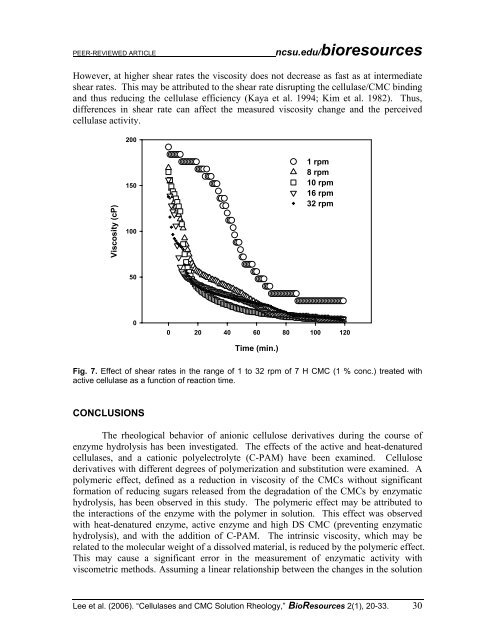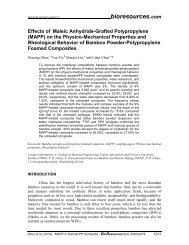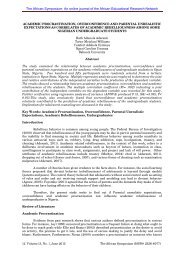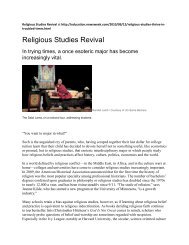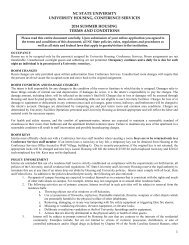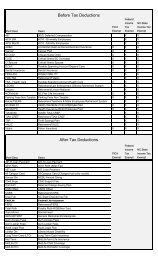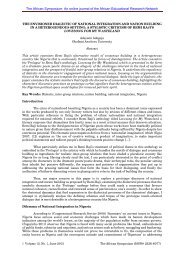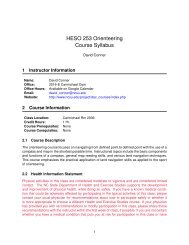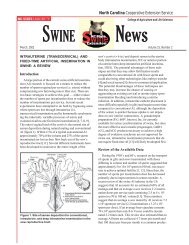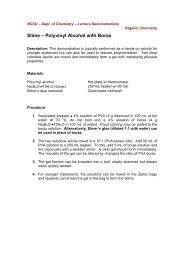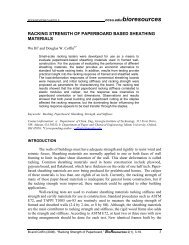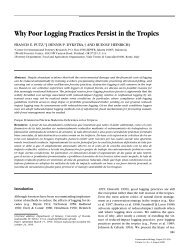Rheology of carboxymethyl cellulose solutions - North Carolina ...
Rheology of carboxymethyl cellulose solutions - North Carolina ...
Rheology of carboxymethyl cellulose solutions - North Carolina ...
Create successful ePaper yourself
Turn your PDF publications into a flip-book with our unique Google optimized e-Paper software.
PEER-REVIEWED ARTICLE ncsu.edu/bioresources<br />
However, at higher shear rates the viscosity does not decrease as fast as at intermediate<br />
shear rates. This may be attributed to the shear rate disrupting the cellulase/CMC binding<br />
and thus reducing the cellulase efficiency (Kaya et al. 1994; Kim et al. 1982). Thus,<br />
differences in shear rate can affect the measured viscosity change and the perceived<br />
cellulase activity.<br />
Viscosity (cP)<br />
200<br />
150<br />
100<br />
50<br />
0<br />
0 20 40 60 80 100 120<br />
Time (min.)<br />
1 rpm<br />
8 rpm<br />
10 rpm<br />
16 rpm<br />
32 rpm<br />
Fig. 7. Effect <strong>of</strong> shear rates in the range <strong>of</strong> 1 to 32 rpm <strong>of</strong> 7 H CMC (1 % conc.) treated with<br />
active cellulase as a function <strong>of</strong> reaction time.<br />
CONCLUSIONS<br />
The rheological behavior <strong>of</strong> anionic <strong>cellulose</strong> derivatives during the course <strong>of</strong><br />
enzyme hydrolysis has been investigated. The effects <strong>of</strong> the active and heat-denatured<br />
cellulases, and a cationic polyelectrolyte (C-PAM) have been examined. Cellulose<br />
derivatives with different degrees <strong>of</strong> polymerization and substitution were examined. A<br />
polymeric effect, defined as a reduction in viscosity <strong>of</strong> the CMCs without significant<br />
formation <strong>of</strong> reducing sugars released from the degradation <strong>of</strong> the CMCs by enzymatic<br />
hydrolysis, has been observed in this study. The polymeric effect may be attributed to<br />
the interactions <strong>of</strong> the enzyme with the polymer in solution. This effect was observed<br />
with heat-denatured enzyme, active enzyme and high DS CMC (preventing enzymatic<br />
hydrolysis), and with the addition <strong>of</strong> C-PAM. The intrinsic viscosity, which may be<br />
related to the molecular weight <strong>of</strong> a dissolved material, is reduced by the polymeric effect.<br />
This may cause a significant error in the measurement <strong>of</strong> enzymatic activity with<br />
viscometric methods. Assuming a linear relationship between the changes in the solution<br />
Lee et al. (2006). “Cellulases and CMC Solution <strong>Rheology</strong>,” BioResources 2(1), 20-33. 30


